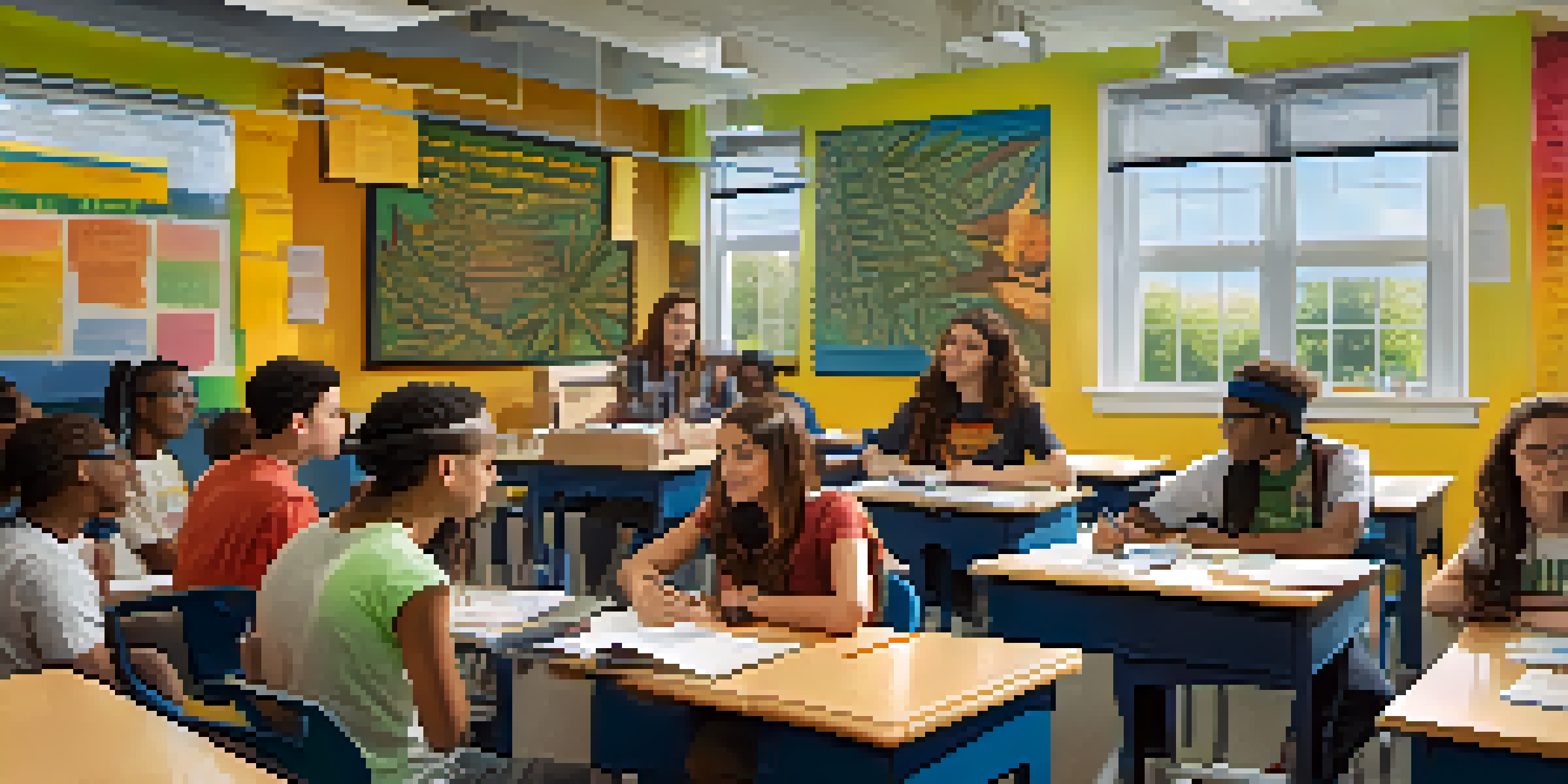Understanding Marijuana: Educational Programs for Youth Today

The Importance of Educating Youth About Marijuana
As marijuana becomes more widely accepted, educating youth about its effects is crucial. Understanding both the benefits and risks associated with marijuana can empower young people to make informed decisions. Educational programs can help dispel myths and provide accurate information, fostering a culture of safety and responsibility.
Education is the most powerful weapon which you can use to change the world.
By teaching youth about the potential impacts of marijuana on their health and development, we can guide them toward healthier choices. This education can also emphasize the importance of legal age limits and the consequences of illegal use. Ultimately, the goal is to create a well-informed generation that understands both the allure and the risks of marijuana use.
Moreover, education can play a key role in addressing the stigma surrounding marijuana. Open discussions can help normalize conversations about drug use, making it easier for youth to seek help or information when needed. This proactive approach can contribute to a more supportive environment for young people.
Current Trends in Youth Marijuana Use
Recent studies indicate that marijuana use among youth has been on the rise, particularly with the increasing legalization across various states. This trend raises concerns about health implications and the potential for addiction. Understanding these patterns is crucial for tailoring effective educational programs that resonate with young audiences.

Social media also plays a significant role in shaping perceptions about marijuana. Many youth are influenced by online content that glamorizes its use, often overlooking the associated risks. Educational programs must adapt to these trends, utilizing platforms that youth frequently engage with to spread accurate information.
Educating Youth is Crucial
Providing accurate information about marijuana empowers young people to make informed choices regarding its use.
Additionally, addressing the reasons behind youth marijuana use is essential. Factors such as peer pressure, mental health issues, and the desire for escapism can drive young people toward marijuana. By understanding these motivations, educators can create more targeted programs that address underlying issues.
Creating Effective Educational Programs
Effective educational programs about marijuana should incorporate interactive and engaging methods. Traditional lectures may not resonate with youth; instead, using multimedia resources, workshops, and discussions can foster a more impactful learning environment. This approach encourages participation and helps young people feel more comfortable discussing their thoughts and questions.
An investment in knowledge pays the best interest.
Collaboration with community organizations and schools can enhance the reach and effectiveness of these programs. By pooling resources and expertise, we can create a comprehensive educational experience that addresses the needs of youth in various settings. This community-based approach also ensures that the messaging is consistent and credible.
Lastly, it is essential to involve youth in the development of these programs. Their input can provide valuable insights into what strategies are most effective and relatable. By empowering young people to take part in their own education, we foster a sense of ownership and responsibility.
Incorporating Real-Life Scenarios in Education
Using real-life scenarios in educational programs can significantly enhance understanding. By presenting relatable stories or case studies, youth can see the tangible effects of marijuana use on individuals and their families. This method makes the information more relatable and shows the potential consequences of drug use in a profound way.
Role-playing exercises can also be beneficial, allowing youth to navigate challenging situations regarding marijuana use. This hands-on approach can help them develop decision-making skills and learn how to handle peer pressure effectively. Such practical experiences create a safe space for youth to explore their values and beliefs regarding drug use.
Real-Life Scenarios Enhance Learning
Incorporating relatable stories and role-playing exercises helps youth understand the real impacts of marijuana use.
Furthermore, inviting guest speakers who have experienced the effects of marijuana firsthand can help personalize the education. Hearing stories from individuals who have faced addiction or health challenges can leave a lasting impression. These narratives can sometimes resonate more than statistics, making the risks more real and impactful.
The Role of Parents and Guardians in Education
Parents and guardians play a pivotal role in educating youth about marijuana. Open communication within the family can create a supportive environment where young people feel comfortable discussing their questions and concerns. When parents are informed and engaged, they can help reinforce the messages learned in educational programs.
It's important for parents to educate themselves about marijuana, as misconceptions can hinder their ability to guide their children. Understanding the current trends, laws, and health implications allows parents to provide accurate information. This knowledge can empower them to discuss marijuana use openly and honestly with their children.
Additionally, parents can participate in educational workshops and resources alongside their children. This joint involvement not only strengthens family bonds but also sends a clear message about the importance of education. Together, families can navigate the complexities of marijuana use and foster a culture of informed decision-making.
The Impact of Legislation on Youth Education
As marijuana laws continue to evolve, so do the educational needs of youth. With different states adopting varying regulations, understanding the legal landscape is essential for effective education. Programs must be adaptable to address these changes and ensure that youth are aware of the laws that govern marijuana use in their area.
Legislation can also influence public perception of marijuana. When laws are relaxed, there may be a corresponding increase in use among youth, necessitating a stronger focus on education. By staying informed about legislative developments, educators can better anticipate the needs of their communities and adjust their programs accordingly.
Parental Involvement Matters
Active participation of parents in marijuana education fosters open communication and reinforces important messages.
Moreover, collaboration with policymakers can amplify the reach and impact of educational initiatives. Advocating for funding and resources to support these programs can lead to more comprehensive education. By working together, we can ensure that youth receive the information they need to make safe and informed choices regarding marijuana.
Evaluating the Effectiveness of Educational Programs
To ensure that educational programs about marijuana are effective, ongoing evaluation is essential. Collecting feedback from participants can provide valuable insights into what works and what needs improvement. This iterative process allows programs to evolve and better meet the needs of youth.
Metrics such as engagement levels, knowledge retention, and behavioral changes can help gauge the success of these initiatives. By analyzing this data, educators can determine the overall impact of their programs and make necessary adjustments. This commitment to continuous improvement demonstrates a dedication to youth education.

Additionally, sharing success stories and outcomes can inspire others to adopt similar programs. Highlighting positive changes in knowledge or behavior can create a ripple effect, encouraging more communities to prioritize marijuana education for their youth. Ultimately, collaboration and transparency in evaluation can enhance the overall effectiveness of these educational efforts.